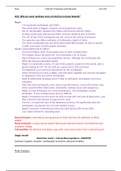EQ1 Tectonic Processes and Hazards 13.3.19
EQ1: Why are some locations more at risk from tectonic hazards?
Nepal
- 7.8 magnitude earthquake, April 2015.
- Was predicated to happen, however not anticipated so soon.
- Sits on the boundary between the Indian and Eurasian tectonic plates.
- As these plates push against each other, pressure builds up due to friction.
- The 25th of April 2015 earthquake was the result of the release of pressure.
- The epicentre was 80km northwest of Kathmandu, depth of 15km.
- The initial earthquakes plus the aftershocks killed 8633 people. As well as injured
21,000, and made 3 million people homeless.
Nepal’s vulnerability and its effects
- Occurred midday, when most people were at work, tending fields.
- This helped reduce the death toll. Yet it destroyed a lot of homes.
- Most of Nepal has a fairly low population density. Although the earthquake did
affect the densely populated capital.
- Nepal is a vulnerable country, it’s one of the poorest countries in the world, with a
global ranking of 197th for the GDP per capita (out of 229 countries).
- The Nepalese as a result was unprepared for the earthquake.
- Weak infrastructure (roads, bridges, and safe water supplies) was severely damaged
or destroyed in the area of the earthquake.
- Most of Kathmandu buildings weren’t built to withstand earthquakes and many
collapsed.
- After the initial earthquake, there were many aftershocks, nearly 100 smaller ones,
which caused further destruction and deaths, making rescue work dangerous.
- Nepal is in the Himalayas, so is very mountainous. The earthquake created
landslides. → also making rescue aid very difficult.
- Nepal’s emergency services were not able to cope with the level of destruction, and
they relied on international aid agencies for help.
- Tourism, an important part of the Nepalese economy, fell significantly after the
earthquake, causing the loss of much needed income.
- Nepal’s economy is estimated to have lost US$5 billion (25% of the GDP).
- Cost US$6.6 billion for rebuilding work.
Natural hazard: a naturally occurring process or event that has the potential to affect
people.
Natural disaster: a major natural hazard that causes significant social, environmental and
economic change.
Vulnerability: the ability to anticipate, cope with, resist and recover from a natural hazard.
Degg’s model
Hazardous event + Vulnerable population = DISASTER
(volcanic eruption, tsunami, earthquake) (economic, physical troubles)
Plate Tectonics





